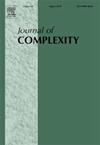Bypassing the quadrature exactness assumption of hyperinterpolation on the sphere
Abstract
This paper focuses on the approximation of continuous functions on the unit sphere by spherical polynomials of degree n via hyperinterpolation. Hyperinterpolation of degree n is a discrete approximation of the -orthogonal projection of the same degree with its Fourier coefficients evaluated by a positive-weight quadrature rule that exactly integrates all spherical polynomials of degree at most 2n. This paper aims to bypass this quadrature exactness assumption by replacing it with the Marcinkiewicz–Zygmund property proposed in a previous paper. Consequently, hyperinterpolation can be constructed by a positive-weight quadrature rule (not necessarily with quadrature exactness). This scheme is referred to as unfettered hyperinterpolation. This paper provides a reasonable error estimate for unfettered hyperinterpolation. The error estimate generally consists of two terms: a term representing the error estimate of the original hyperinterpolation of full quadrature exactness and another introduced as compensation for the loss of exactness degrees. A guide to controlling the newly introduced term in practice is provided. In particular, if the quadrature points form a quasi-Monte Carlo (QMC) design, then there is a refined error estimate. Numerical experiments verify the error estimates and the practical guide.

 求助内容:
求助内容: 应助结果提醒方式:
应助结果提醒方式:


